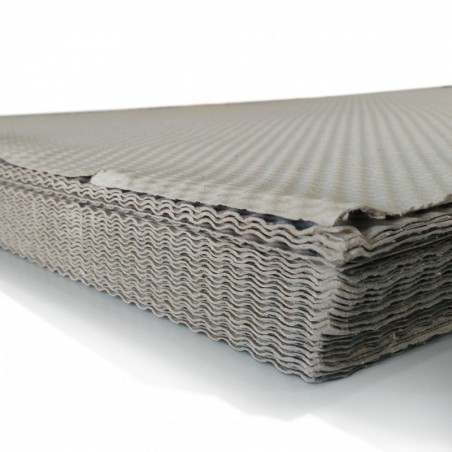The dispersion of matings described in the previous article is even more drastic on farms operating in bands over one week. With more time between matings, there is also more time for displaced sows to appear and the problems they generate are more serious.
The worst situation occurs with farms that impose a rotation of 4 weeks in maternity (batches every 2 and every 4 weeks) because they force weaning at 21 days as maximum.


As we can see, now the problem is even worse than with weekly batches.
Matings on Monday, Tuesday and Wednesday of mating week → farrowings will be Wednesday, Thursday and Friday → weaning at 20, 21 and 22 days.
Matings from Thursday of mating week until Thursday of weaning week → farrowings from Saturday to Thursday of weaning week → weanings between 19 and 13 days.
Matings from Friday of weaning week, they can enter the next batch → deliveries on Sundays, but limiting the time of depopulation of the rooms.
E xample: 50 births / 2 weeks
Imagine a farm with 10 rooms with 10 places each and a target of 50 farrowings every 2 weeks.
If that farrowing objective were to be achieved, the sows would be weaned at 21 days maximum, but as we have seen, we will certainly have between 10-20% of weanings at less than 20 days and even some with only 14 days.

The typical operation of this system would be to always allocate the same rooms to even batches and same rooms to odd batches:
- Batch 1: In rooms 1-5
- Batch 2: In rooms 6-10
- Batch 3: In rooms 1-5
- Batch 4: in rooms 6-10
- Batch 5: in rooms 1-5
- Batch 6: in rooms 6-10
- …
Again, a good option to avoid these early weanings would be to reduce the farrowing target, rotating at birth and go through the 10 rooms continuously, without leaving gaps. Thus an “extra” rooms will be generated, just as we saw with weekly batches.
E xample: 45 births / 2 weeks
(target lowered by 10%)Imagine that we begin to enter the batch into empty farrowing pens. The situation would be as follows:
Batch 1 (yellow): the bulk of the batch (sows mated during mating week) enters rooms 1, 2, 3 and 4.
The 5 lagging sows of the batch (approximately 10%) occupy half of room 5. The other half of the room is, for now, empty.

Batch 2 (orange): finish filling room 5 and rooms 6, 7, 8 and 9. In room 9 the sows that will farrow at a later date should remain (those mated between batches).

To enter batch 3 (green) the yellow batch must wean at 21 days.
The bulk of the 40 sows covered during mating week of the green batch enter the room 10, 1, 2 and 3. Half of room 4 should be filled with approximately 10% of lagging sows.

→ Lagging sows from batch 1 (yellow) are not weaned and remain in room 5. They are to be weaned in the next batch (at 28-32 days). As we saw in the previous article in this batch we will probably find the majority of the smaller and lagging piglets. They will also serve to make nurse sows in order to advance the excess of piglets from the red batch.
In this way we obtain a minimum age at weaning of 20 days, with some sows being weaned at up to 32 days.

Batch 4 (gray) just filled the remainder of room 4, the entire room 5, 6, 7 and 8. The entire room 9 is available for sows with little lactation time and small piglets. In this room we can wean only the sows that interest us.

Batch 5 (yellow) enters rooms 9, 10, 1, 2 and half of room 3. Room 3 should have been completely emptied to respect All-in-all out, so there will be empty places once the yellow batch enters.
Half of room 4 is available for the batch’s lagging sows.

Batch 6 (orange) enters half of room 3 as well as rooms 4, 5, 6 and 7. Again, we now have an entire room to extend the lactation of sows and piglets of the grey batch.

Batch 7 (green) enters rooms 8, 9, 10, 11 and half of room 1. Now we just have half of room 3 to leave the sows with little lactation time.

As we see, by lowering the baseline target by 10% on a farm with 10 farrowing pens, we can attain an “extra” half-room (for the approximately 10% of displaced sows in the batch) and sows the lot) and then an entire “extra” room (room for roughly 20% of sows).
Advantages :
Virtually no weaned sows at less than 21 days of lactation, as long as there is an excess of sows between batches, due, for example, to not programing the servicing of gilts with altrenogest, weaned sows with a weak estrus or excessive returns.
This extra space can also be used to extend the lactation of piglet litters that weer born small or those that are delayed during lactation.
Greatly facilitates the task of generating nurse sows, something that, when searching for the maximum possible farrowing target with batches every 2 weeks, is a major problem.
The size of weaned piglets is rather homogenized: 80-90% of good piglets are weaned at 21 days, the rest (the bad ones) are weaned over time.
This can allow farms that hadn’t been able to impose rotation every 4 weeks due to a limited number of gestation places, to be able to by reducing farrowing objectives.
The system is applicable to other types of BM, but is also gaining interest in systems with farrwoing pen rotations of 4 weeks (batches every 2 to 4 weeks).
Disadvantages :
The major limiting factor of this system is that we need many rooms in order to maintain a correct All in –All out management. In the example we have assumed a farrowing pen with 10 rooms, which is quite abnormal in small or medium farms (such as those that typically operate in batches longer than a week). 8 rooms will also usually work, but when you have fewer rooms, you must increase the percentage of birth rate reductions in order to generate sufficient extra space to allow for comprehensive depopulation.
We must bear in mind that the more we reduce births, the less interested we are in operating in batches every 2 weeks. For example, if we need to reduce the farrowing target by 20% for us to carry on with this system we will be better off with batches every 3-2 weeks, pushing the limits of the pen. We will have virtually the same sows and we can wean the bulk of the batch at 28 days.
Conclusion
A in the case of weekly batches, again, we are not saying anything new. This concept has already been put into practice when we allocated certain rooms as “extra” on farms operating in batches above one week. The difference is that these “extra” rooms were always the same ones and often times they break the all in - all out management.
With this new approach, the “extra” room is different for each batch and always respects depopulation. This is accomplished by entering the sows to farrow in strict order and without leaving gaps where one batch ends and the next begins.







